
Figure 1. An array of slides prepared by members of the Bourgogne family
Joseph Bourgogne, 1803 - after 1883
Charles Bourgogne, 1832 - 1890
Eugene Bourgogne, 1838 - after 1909
and
"H. Bourgogne" (Hippolyte Claude Pouilliart, 1826 - 1895)and
Bourgogne Frères / Bourgogne Brothers
Bourgogne and Pouilliart / Pouilliart - Bourgogne
Bourgogne and Alliot
C. Alliot
by Brian Stevenson
last updated January, 2022
Many of Joseph Bourgogne’s contemporaries considered him to be one of the 19th Century’s most important preparers of microscope slides. His mounts won numerous medals at exhibitions in Paris and London, and were prized by microscopists the world over. He was also credited with discovering the male sarcopid mite of humans. His sons, especially Eugene, also received awards for their high-quality microscopical preparations.
Edmund Dixon, writing in 1857, indicated the esteem in which Joseph Bourgogne was held, “As we treasure cabinet-pictures by Teniers or the Breughels, so shall we set an exalted value on charming bits of still-life from the studios of Amadio or Stevens, on insect-portraits by Topping, on botanical groups by Bourgogne the Elder, and on works by anonymous artists, whose names, though not their productions, still remain unknown to fame.”
But, as is so often the case, the Bourgognes’ fame diminished over time. When Brian Bracegirdle published Microscopical Mounts and Mounters in 1998, he possessed very little information on the Bourgogne family, and Joseph and his sons were not described in any detail. Subsequent publications in the Quekett Journal of Microscopy by Bracegirdle, Stanley Warren, Pierre Girodet, and Robert Nuttall have provided some details on Joseph Bourgogne. I have located further information on this important microscopist and his family, permitting a comprehensive view of the contributions to microscopy by the Bourgogne family and their colleagues.

Figure 1.
An array of slides prepared by members of the Bourgogne family
Joseph Bourgogne
Joseph Bourgogne was frequently referred to as “père” (father), with his sons referred to as “fils” (sons) or “frères” (brothers). Vital statistics for early 1800s France are scarce, but enough have been located to piece together a time-line for Joseph and his family. According to a record of his October 8, 1828, marriage to Marie Jeanne Francoise Bertet, Joseph’s parents were named Pierre and Claudine (née Deschamps) (Figure 2). The October, 1881 death record of Joseph's daughter, Jeanne Marie, stated that Joseph was then seventy-eight years old, providing his birth year as 1803.
Joseph and Marie are known to have had four children: Marie Rose (born in 1829), Charles (born in 1832), Eugene (born in 1838), and Jeanne Marie (born in 1841). Marie died on January 15, 1841, following the January 2, 1841 birth of daughter Jeanne Marie. An associated slide-maker who labeled their work as “H. Bourgogne” was undoubtedly Marie Rose's husband, Claude Hippolyte Pouilliart.
Charles, Eugene, Pouilliart, and their various partnerships, will be discussed in separate sections below.
Both the catalogue for the 1862 London International Exhibitions and a 1902 description of son Eugene state that Joseph Bourgogne established his microscopy workshop in Paris in 1835. Joseph’s 1862 catalogue stated that he had “twenty-five years of practice”. Charles Robin, in Traité du microscope, described Joseph Bourgogne as having been producing slides since 1825, which was probably a typographical error.
The earliest known record that describes Bourgogne’s microscopy work is a Citation Favorable award given in 1839 at the Produits de l'Industrie Francaise exhibition. The 1839 Annuaire Général du Commerce, de l'Industrie, de la Magistrature et de l'Administration (which would have been compiled in late 1838) gives Bourgogne’s address as 15 Quai Napoléon, and lists him under “Opticiens” (Figure 3). That is the same as the home address listed on Eugene’s October 12, 1838, birth registration (Figure 18).
From ca. 1836 onward, 15 Quai Napoléon was also the address of an “opticien” named Bouquet (Figure 3). He was probably the same person who had partnered ca. 1830-1835 with Georges Oberhaeuser (1798-1868) and Achille Trécourt. Bouquet had a workshop on Quai Napoléon until ca. 1840, when he moved to 13 Rue Arcole. Bourgogne and Bouquet both working in the same building raises the possibility that they may have had a collaboration.
An extended description of Bourgogne in the 1840 Almanach Général des Commerçants de Paris states that he had 1200 different objects available, mounted as transparent or opaque objects, of animal, plant, and mineral origin (Figure 4).
During 1844, Bourgogne moved to 6 Rue Constantine. He earned a Bronze Medal in that year’s Expositioralty chn des Produits de L’industrie Francaise: “M. Bourgogne a acquis dans les préparations microscopiques une supériorité incontestable; personne n'a porté au même degré l'art si délicat d'ajuster entre deux verres, et de conserver pendant longtemps, les insectes, les animalcules, les organes séparés, et en un mot, tous les éléments infiniment petits des trois règnes qui ne peuvent être étudiés qu'au microscope. Les collections qu'il a présentées à l'exposition sont d'un grand intérêt. Le jury décerne à M. Bourgogne une médaille de bronze” (roughly translated as “M. Bourgogne has acquired in the microscopic preparations an incontestable superiority; No one has carried to the same degree the delicate art of adjusting between two glasses, and of preserving for a long time insects, animalcules, separate organs, and, in a word, all the infinitely small elements of the three kingdoms which can only be studied under the microscope. The collections he presented at the exhibition are of great interest. The jury awards Mr. Bourgogne a bronze medal”). The jury’s report listed two addresses for Bourgogne: 6 Rue Constantine and 17 Rue des Marmousets. This is the only mention yet located of Bourgogne at Rue des Marmousets, so its significance is not known.
Around 1849, Bourgogne moved to 2 Rue d’Arcole. This was near the workshop of his old colleage, Bouquet, who lived at 13 Rue d’Arcole.
The Jury’s report of the 1849 Les Produits de l'Agriculture et de l'Industrie Exposes elaborated on Bourgogne’s dedication to preparing microscopical specimens, and bemoaned the low financial rewards: “M. Bourgogne présente à l'exposition des préparations microscopiques qui sont faites avec tant d'art et d'adresse, qu'il paraît impossible d'arriver à une plus grande perfection. Déjà cité favorablement en 1839, et récompensé d'une médaille de bronze en i844, cet habile microscopiste semble n'avoir vu dans ces encouragements que des motifs pour redoubler de zèle, pour étendre ses recherches et pour porter encore plus haut le talent, déjà si éminent, qu'il avait acquis ; ce sentiment, dans M. Bourgogne, n'est pas de l'émulation, c'est l'amour même de la science et de la vérité, car depuis longtemps il est sans concurrent en Europe dans ce genre de préparations. Il pourrait profiter de cet avantage, qui est assurément bien rare, pour élever ses prix et courir après la fortune, soit pour lui, soit pour sa nombreuse famille; mais, sous ce rapport, l'amour de la science l'emporte encore : il veut que ses produits soient à la portée de tous les curieux, et surtout à la portée de tous les observateurs, qui, en général, ne peuvent pas faire de grands sacrifices pécuniaires. Or, il n'en est pas de ces objets comme de ceux qui se font à la mécanique et qui peuvent se multiplier indéfiniment: ici chaque objet, chaque préparation doit passer par la main de M. Bourgogne; nulle autre ne peut la suppléer, et cette condition forcée limite extrêmement le nombre des objets qu'il peut livrer dans le cours d'une année: car pour en faire 9,000 il en faut faire 30 chaque jour, et cependant 9,000 à 50 cent., en moyenne, ne font de recette brute que 4,500 francs. N'est-il pas infiniment regrettable qu'une telle industrie ne puisse pas s'exercer sur un capital qui soit mieux proportionné à l'étendue des services qu'elle rend à toutes les sciences d'observation?” (“M. Bourgogne presents microscopic preparations to the exhibition, which arrpose made with so much skill and art that it seems impossible to be of greater perfection. Having received an Honorable Mention was awarded in 1839, and a Bronze Medal in 1844, this clever microscopist seems to have seen in these awards only motives for increasing his zeal, to extend his researches, and to raise his eminent talent even higher. M. Bourgogne is not driven by emulation, it is the very love of science and truth, and for a long time he has been without a competitor in Europe. He might profit by this advantage, which is certainly very rare, to raise his prices and chase after fortune either for himself or for his numerous family. But, in this respect, the love of science still prevails. He wants his products to be within the reach of all the curious, and especially within the reach of all observers, who in general can not spend much money. Now these objects are not like those which are made to mechanics, and which can multiply indefinitely; here every object, every preparation, must pass through the hand of M. Bourgogne. No other can supply it, and this forced condition greatly limits the number of objects which he can deliver in the course of a year: for to make 9,000 it is necessary to make 30 each day, and yet 9,000 for 50 centimes, on average, yields gross receipts only 4,500 francs. Is it regrettable that such effort cannot be rewarded in better proportion to the extent of the services he renders to all the sciences of observation?”).
At the 1851 Great Exposition of London, “M. Bourgogne exhibits a large collection of microscopical preparations, illustrating the structure of insects, and among them a beautiful dissection of the tracheae of a caterpillar, sections of human and other bones and teeth, and a number of sections of minerals for the polarizing apparatus. All of them are well mounted”. He earned an Honourable Mention.
Several sources credit Joseph Bourgogne with discovering the male of the scabies mite (Sarcoptes scabiei, circa 1850, although there were other claimants to the title of discoverer. Previously, it had been debated whether or not all scabies mites were female, and reproduced asexually. A contemporary wrote, “M. Bourgogne discovered the male of the human itch-insect, which discovery made a great sensation at the time, not having been seen before. It seems to have been completely unknown until 1840, probably because it is never found in the furrows of the skin, as the female always is. Nobody then suspected that the male lived constantly on the surface of the epidermis; being also smaller than the female, it escaped observation. Ten years afterwards, amongst three hundred of these insects, which Monsieur B. had received in several lots, he recognized a single male by its agility, and by its fourth pair of paws, which had suckers at their tips, instead of long bristles, like the female. He valued the precious acarus as a rarity, and it formed part of his collection at the London exhibition in '52. But, Dr. Bourgogne had the indiscretion and the hardihood to publish a pamphlet denying the existence of this male acarus, as well as of the acarus of the rabbit, and others. M. Bourgogne, urged by his friends, started for London, and established the truth of the fact by bringing back the treasured object, and having a drawing made from it, which appeared in the Annales des Maladies de la Peau. And then, visiting the hospital of St. Louis, he captured several males on the skin of patients, in the presence of Dr. Hardy and sundry medical students. The question was of considerable theoretical and physiological importance—touching, as it did, spontaneous generation and the reproduction of parasites in general. M. Bourgogne proved that itch-insects are males and females.” Girodet (2001) translated Bourgogne as stating, “for the male Sarcopte of man, I was the first to discover, in 1840, which remained unknown up to 1851.”
Girodet (2000) reported that Joseph Bourgogne was a major supplier of diatom mounts, and by 1850, was the main source of mounted Pleurosigma angulatum. Bourgogne provided the diatom test slides used in famous resolution studies by van Heurck and by Woodward.
An 1880 essay by “Rusticus, Jr.” on a microscopist pseudonymed “Pococurante” related that, “we used to have great difficulty in finding good slides. A large part of my time was taken up in ‘hunting’ for them. Many and many a day have I passed with Bourgogne pere in Paris, going over his slides. When searching for tests, I was well rewarded if I found one good one after five or six hours’ examination of a couple of hundred slides. ‘Micro’ was my great rival; he would ‘hunt’ for good slides with all the zeal of a ‘grunter’ after truffles. He was very ardent in affecting exchanges; I have heard him say he has given as many as ten, twenty – aye, forty slides, to obtain one that he coveted. There was one slide in his collection that had ‘given me in the eye;’ it was a colossal Angulatum: the cover-glass was so thick that his lenses couldn’t ‘get at’ it. I don’t care to confess to what baseness or cajolery I resorted to induce him to let me have that slide.”
Another address change occurred around 1854, to 4 Rue Massillon. This may have been a re-numbering of the house, or, at most, a short move. Massillon and Arcole were close together, and an 1863 Parisian directory gave Bourgogne’s address as “rue d’Arcole 19, ci-devant Massilon 4” (“Rue Arcole 19, in front of Massilon 4”).
The 1855 Paris Exposition earned Bourgogne another award, a First Medal for his “preparations anatomiques vegetales et animales, pour les observations microscopiques”. This medal is highlighted on his slides from that period.
Joseph Bourgogne’s 1862 catalog states that he produced three quality levels of slides. Girodet translated the catalog as describing “cheap preparations of second and third quality levels, to be used with low price microscopes”. Dixon (1857) wrote, “M. Bourgogne's best preparations are excellent, with the merit of being determined and named; his inferior preparations are very indifferent, full of bubbles and dirt. For inspection by persons who have had a certain experience, some of these cheap French preparations are useful; but, as articles of luxury and ornamental art, the English are superior. M. Bourgogne classes his productions into first, second, and third-choice specimens. When Beau Brummel's valet came downstairs from dressing his master for dinner, he generally brought with him an armful of discarded white cravats. ‘These,’ he explained, ‘are our failures.’ Just so we may suppose that M. Bourgogne's third choice preparations—some of them as low as threepence-halfpenny each (what can you expect for threepence-halfpenny?) are, what he is too prudent, as well as too honest, to sell at higher prices; ‘our failures,’ in short. And, as good French preparations are costly, while bad ones are not cheap, an English collector has no motive to go out of his own country, unless perhaps it be for some novelty in the way of morbid anatomy, or other exceptional cases.”
Dixon also wrote, “Amongst continental preparers, Joseph Bourgogne, of Rue Notre-Dame, Paris, stands preeminent. He is a man whose whole soul is in his art, and he naturally speaks of microscopic preparation as one of the most important aids to science. He has had the great advantage of constant communication with the most learned men of Paris, who have aided him in their several departments. From Robin, he has had lessons in anatomy; from Thuret, in the structure of algae. Of late, his health has become impaired in consequence of severe application, while his business is steadily on the increase. He proposes, therefore, to divide his grand microscopic empire into three kingdoms - the mineral, the vegetable, and the animal - one of which he will bequeath to each of his three sons.” Dixon’s essay was obviously cobbled together from various sources, so it is impossible to know if he wrote with any personal knowledge of Bourgogne’s intentions. It is clear from surviving slides made by the Bourgogne sons that there was never a division of subject matter. Moreover, Joseph Bourgogne continued making and selling his slides until at least 1883.
H Bourgogne left his father’s business during 1859, and set up a business under his own name (see below). The following year, Eugene separated from his father, and joined with H as “Bourgogne Frères”. Being first to depart does not imply that H was the eldest, since Charles remained with his father for several years after his younger brother Eugene went his own way.
Joseph exhibited at the 1862 London International Exposition, as did also the Bourgogne Fréres. Each earned an Honourable Mention, “for an extensive series of microscopic objects”.
Charles separated from his father’s business in 1862. He set up a shop under his own name, and does not appear to have ever joined in partnerships with his brothers or anyone else.
In addition to his sons, other people assisted Joseph through the years. A description of the 1867 Paris Exhibition noted that professional slide-maker Charles Marchand had previously worked for Joseph Bourgogne.
Joseph relocated to 8 Fossés St. Victor during 1863.
Neither Joseph nor Charles exhibited at the 1867 Paris Exposition. H and a colleague named C. Alliot did show there, and won a Bronze Medal. It is possible that Eugene could have been part of the Bourgogne and Alliot partnership in 1867, although he was certainly not a partner in 1868 (see below).
Joseph’s final move in Paris occurred in 1871 or ’72, to 2 Rue Pascal. Although Joseph was no longer showing at exhibitions, he was still a very active slide-maker. He issued a catalogue in 1874, of “préparations microscopiques d'anatomie et de physiologie des deux règnes organisés de la nature” (“preparations microscopiques of anatomy and of physiology of the two organized kingdoms of the nature”). He also took a swipe at his sons, declaring himself, “Jh Bourgogne père, seul inventeur et fondateur de ces collections”, (“Jh Bourgogne the father, sole inventor and founder of these collections”).
An advertisement in 1877 presaged Joseph’s departure from Paris (Figure 11). The next month, the identical advertisement appeared in the same journal, accompanied by Eugene’s name and address. This suggests that Joseph turned his business over to Eugene.
During late 1877, Joseph left Paris for Merdrignac, in Côtes-du-Nord. He was recorded as then specializing in microscope slides of lichens. The October, 1881 record of daughter Jeanne Marie's 1881 death provided Joseph's addresss as Côtes-du-Nord. In 1883, he was mentioned as a supplier of specimens in an issue of Revue de Botanique. I have not found records of Joseph Bourgogne from after that date, when he would have been 80 years old.
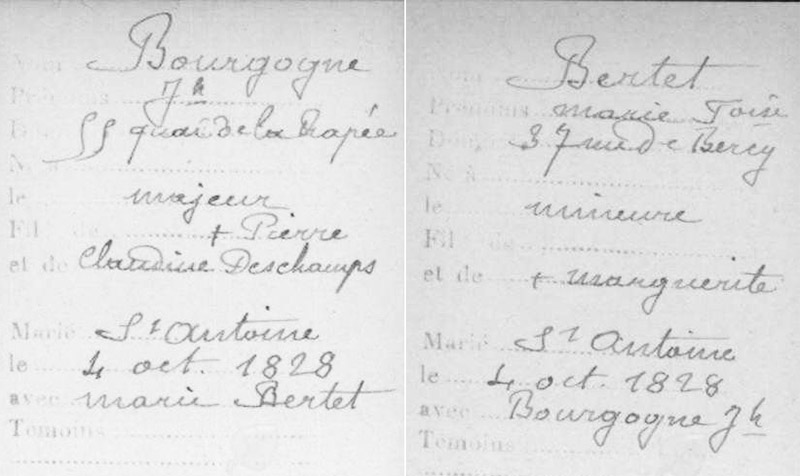
Figure 2.
The 1828 marriage records of Joseph Bourgogne and Marie Bertet. His address was on Quai de la Rapée.
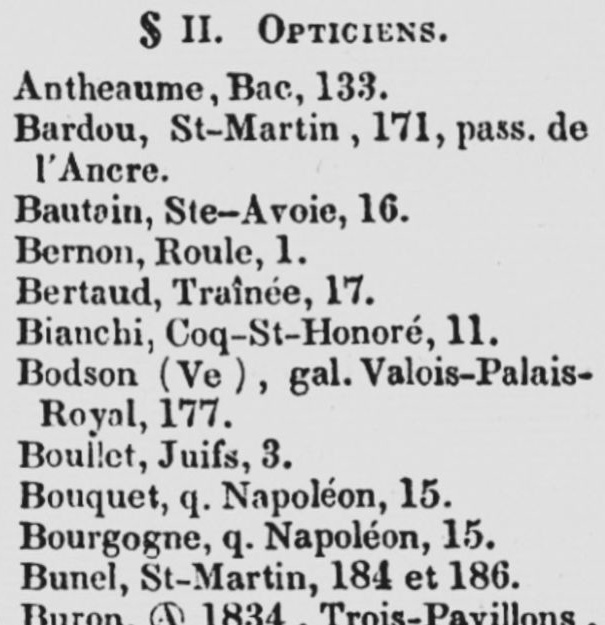
Figure 3.
Excerpt from the 1839 “Annuaire Général du Commerce, de l'Industrie”, the earliest record of Joseph Bourgogne as an independent businessman. That same year, he earned an Honourable Mention award for his “preparations d’objets microscopiques” at the Central Exposition of the Products of France.
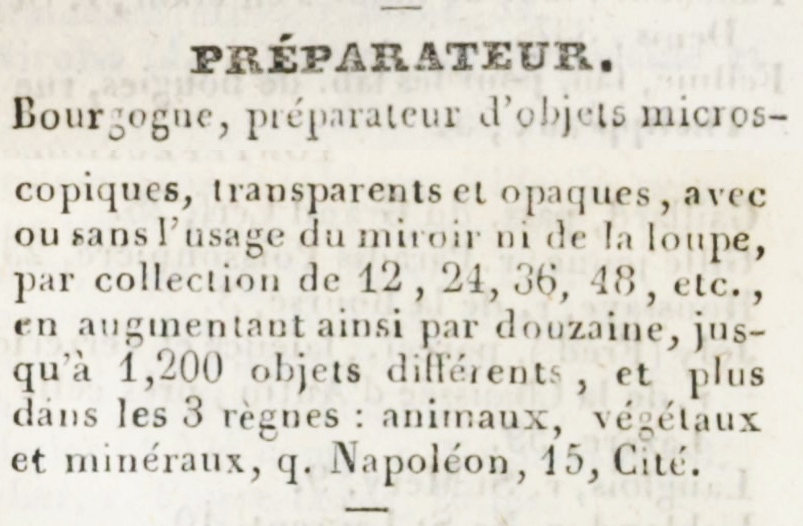
Figure 4.
1841 description of Joseph Bourgogne’s microscopical preparations.

Figure 5.
Early microscope slides attributable to Joseph Bourgogne. Another unsigned slide of Lepisma saccharina scales is shown in Bracegirdle’s Microscopical Mounts and Mounters, Plate 3-F, with a secondary label from Abraham and Dancer. That label dates these slides to the early 1840s. Each slide consists of a 1.6 x 6 cm (5/8 x 2 inch) plate glass slide with a small, thin cover glass, wrapped in light brown paper with bright green papers at each end. The similarly-constructed slide labeled with Andrew Pritchard’s name and address was probably also made by Joseph Bourgogne. A similar slide is shown in plate 2-F of Microscopical Mounts and Mounters. Nuttall reported that Pritchard imported, re-labeled and sold slides made by Joseph Bourgogne. Pritchard also purchased Bourgogne’s slides for his own collection. The two men evidently enjoyed a close, personal relationship, as Pritchard is recorded as having extended invitations to Bourgogne and his family to stay with him while visiting London. A later, circa 1855 slide bearing J. Bourgogne’s name is shown for handwriting comparison. All are “continental” size, 1.6 x 6 cm (5/8 x 2 inch). Bourgogne also produced slides with this style of covering that are comprised of two glass slips of the same thickness (like those shown in Figure 6).
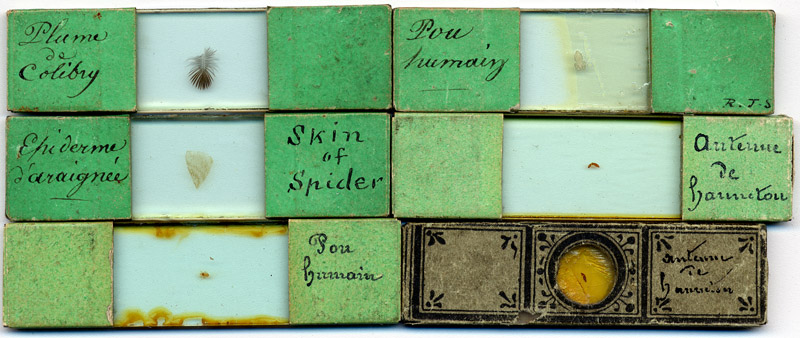
Figure 6.
Another early style of microscope slides attributable to Joseph Bourgogne. Each is comprised of two identically sized glass slips. The specimens are held between the two slips. Balsam serves as both fixative and adhesive to hold the slide together. Both ends are usually covered with green paper, although some with yellow paper are known. The lower right slide has been covered completely with a patterened paper associated with the Bourgogne family’s later output. This may represent a repackaging of old stock. All slides are “continental” size, 1.6 x 6 cm (5/8 x 2 inch).
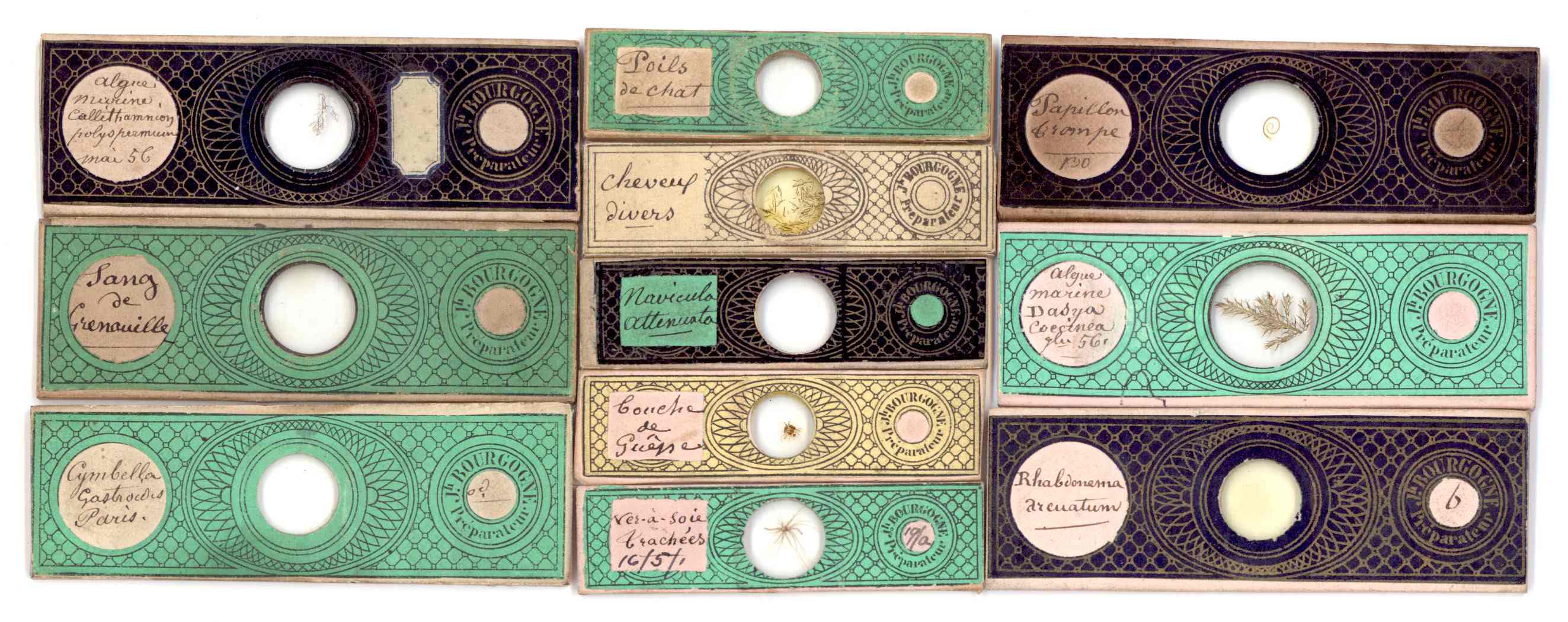
Figure 7A.
A variety of microscope slides by Joseph Bourgogne, two of which are dated 1856 in the maker’s hand. All are completely wrapped with paper. Circles or rectangles were cut from the upper papers to reveal a contrasting paper underneath, on which the specimen description was written. This method avoided the possibility of label loss, as could occur if gummed labels were affixed to the slides. Both “continental” (5/8 x 2 inch, 1.6 x 6 cm) and RMS standard sizes (1 x 3 inches, 2.6 x 8 cm) are shown.

Figure 7B.
Two small, unsigned microscope slides with Joseph Bourgogne's handwriting. These accompanied a ca. 1857 microscope manufactured by (Georg Oberhaeuser and Edmund Hartnack), Paris. These indicate that Bourgogne supplied unsigned slides for retail by other dealers.

Figure 8.
Later slides from the Joseph Bourgogne shop, dated 1858 through 1860. Slides with this type of label and dated as early as 1856 are known. The maker’s name labels advertise Bourgogne’s medal from the 1855 Paris Universal Exposition. The dates on this type of slide suggest that Bourgogne transitioned from paper-wrapped slides, such as shown in Figure 3, to the simpler labels right after he won the 1855 medal. Bourgogne’s 1862 catalog described slides having this type of label as being his best, first-class mounts. It is notable that Bourgogne was routinely preparing slides that were not completely wrapped in paper 10-20 years before his English counterparts. All of these slides are the modern standard size, 1 x 3 inches (2.6 x 8 cm).
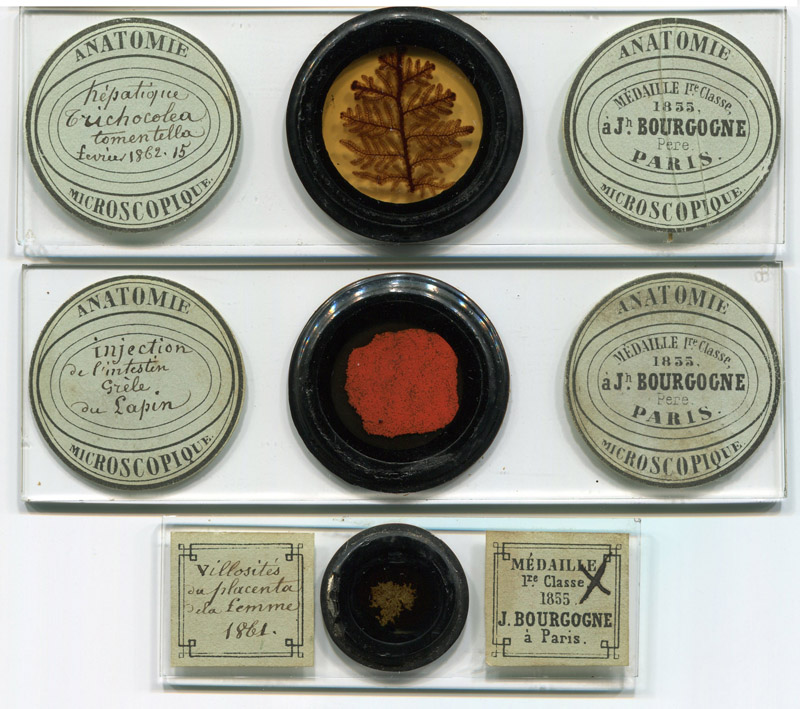
Figure 9.
Two very unusual slides by J. Bourgogne, measuring a massive 1 1/2 x 4 7/8 inches (3.6 x 12 cm). A standard 1 x 3 inches (2.6 x 8 cm) is shown for comparison. Joseph advertised slides of this size in his 1862 catalogue, writing that the standard 1 x 3 inch slide ‘being not always sufficient for large size samples, useful to be prepared whole, I had to introduce a third format able to be inserted in spite of its width, as easily as the (1 x 3 inch), onto the stage of the big achromatic microscope’ (as translated by Girodet, 2001).

Figure 10.
Microscope slides labeled Joseph Bourgogne, accompanied by slides labeled either Eugene or Charles Bourgogne. The handwriting similarities suggest that these J. Bourgogne slides were made by his sons.

Figure 11.
1877 advertisements from Joseph and Eugene Bourgogne, which appeared in the September and October issues, respectively, of Journal de Micrographie. The identity between the two advertisements indicates a close business relationship between the father and that son. As this was near the time Joseph moved away from Paris, the advertisements may reflect Eugene taking over his father’s business.
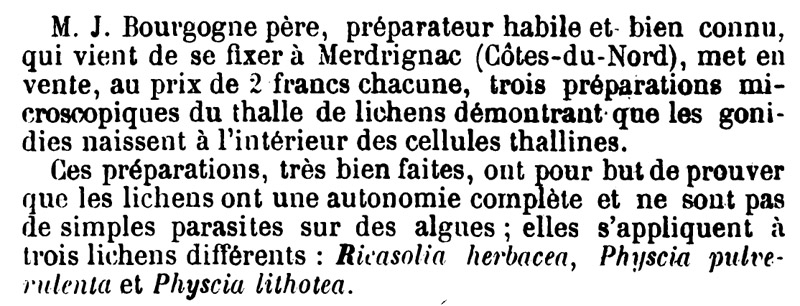
Figure 12.
An 1878 notice that Joseph Bourgogne was preparing and selling preparations of lichens from his new home in Merdrignac, Côtes-du-Nord.
Charles Bourgogne
Charles Auguste Bourgogne was born on July 15, 1832, in the La Chapelle district of Paris (Figure 13).
Handwriting comparisons suggest that Charles stayed with his father for a longer time than his siblings. Charles was living with his father at the time that he married Anastasie Ponceau in October, 1861. He is first identified as having an independent business in the 1863 Annuaire-Almanach du Commerce, de l'Indistrie, de la Magistrature et de l'Administration, being described as providing, “anatomie microscopique, spécialité de préparations entomologiques” (Figure 14). His shop was located at 12 Rue Bourtibourg, Paris, a site that he occupied until at least 1891.
He present a display of slides at the 1867 Paris Exposition, described as being “primarily beautiful plant sections”. He did not win an award. Charles does not appear to have shown his work at other exhibitions.
Charles' shop is listed in Paris directories through the late 1880s. He died on December 5, 1890, at his 12 Rue Bourtibourg home. The death record gave his occupation as "naturalist, implying that he was still working at the time of his death (Figure 13).
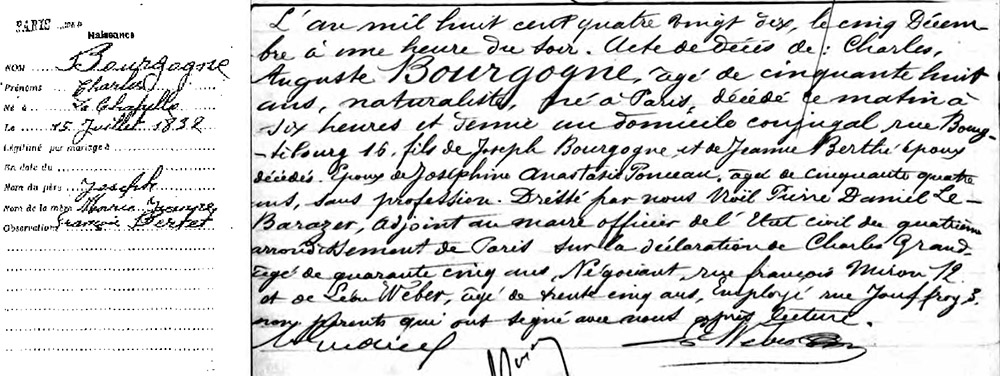
Figure 13.
The 1832 birth and 1890 death records of Charles Bourgogne.
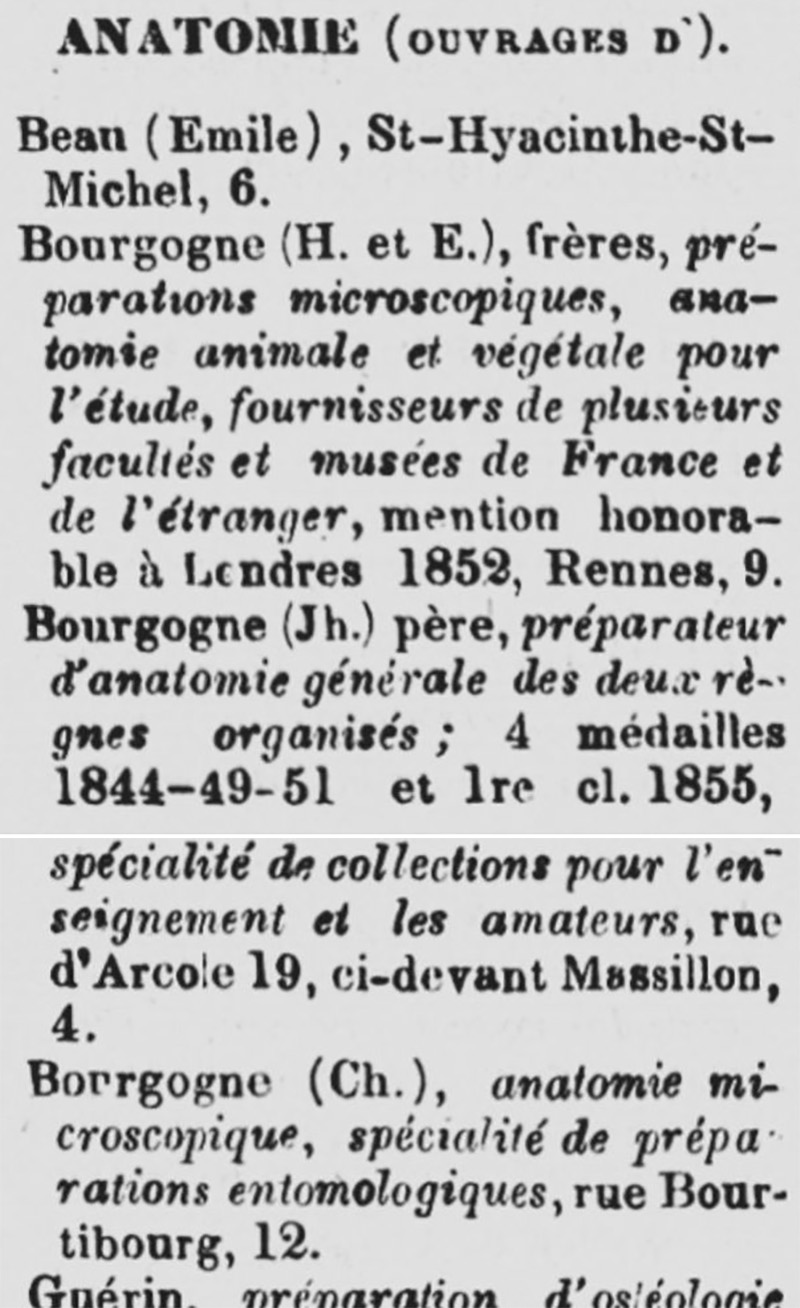
Figure 14.
Excerpt from the 1863 Annuaire-almanach du commerce, de l”indistrie, de la Magistrature et de l’Administration, the earliest identified record of Charles Bourgogne having a business of his own. Note that Eugene and H had a separate shop as Bourgogne Freres.
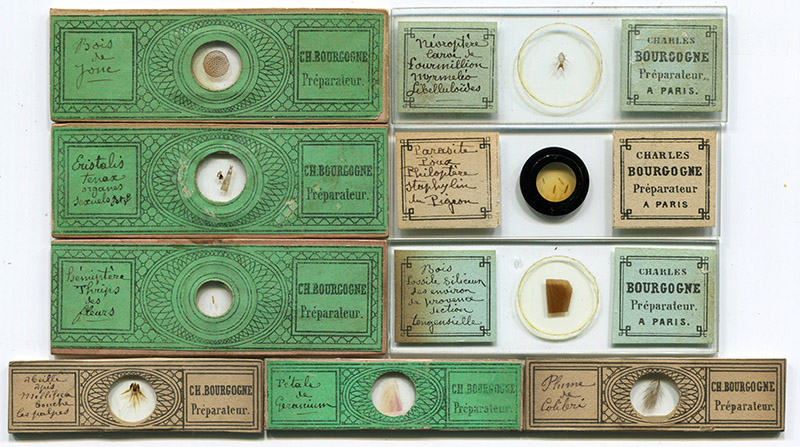
Figure 15.
Examples of microscope slides that were prepared and sold by Charles Bourgogne. The fully paper-wrapped slides, with patterned papers similar to those of father Joseph, are probably the oldest of these. Charles produced both standard (1 x 3 inch) and smaller continental slides.
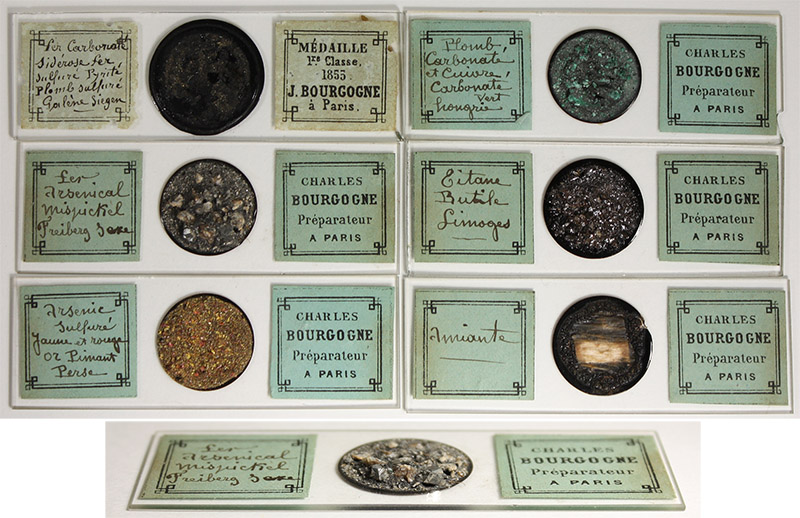
Figure 16.
Slides of mineral specimens that were prepared by Charles or Joseph Bourgogne. All are uncovered specimens of glued-together crystals and powders, are not polished on the top surface, and are intended for indirect lighting only. These are probably representative of the mineral slides that the Bourgognes were advertised as having sold.
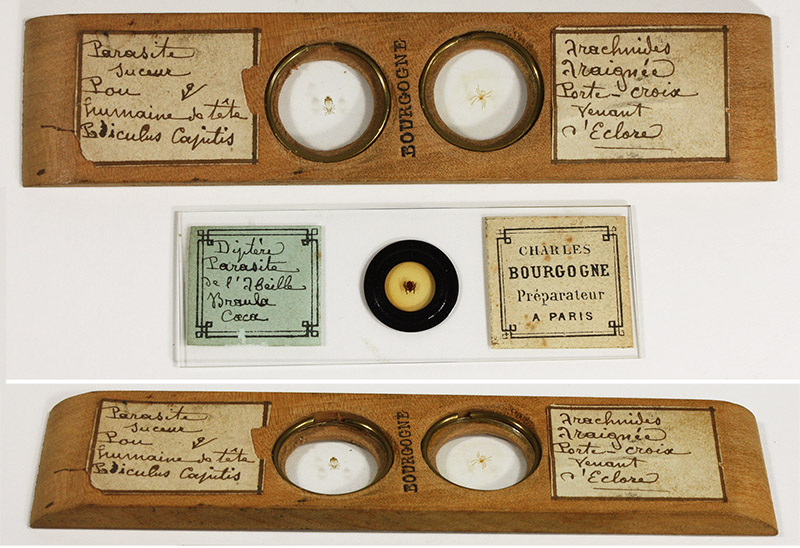
Figure 17.
A wooden slide for projection microscopes that is stamped “Bourgogne” and carries labels with Charles’ handwriting. A standard 1x3 inch slide is shown in the top panel as a size comparison. It is not known whether this slide was produced when Charles worked with his father, or later, when he had his own business. Joseph’s 1862 catalogue stated, ‘For the solar, gas and photo-electric microscope, the objects are of first quality level, mounted between 20 millimeter wide glass discs into two-hole wooden object holders bevelled at each end, in order to facilitate the sliding on the instrument stage and to protect the objects from too high pressure’ (as translated by Girodet, 2001).
Eugene Bourgogne
Eugene was born on October 11 (recorded October 12), 1838, while his father was working alongside Bouquet at Quai de Napoléon (Figure 18).
Undoubtedly, Eugene and his siblings worked for Joseph throughout their childhoods. Cornu (1902) stated that Eugene became a partner in his father’s business in 1855, when he would have been 16-17 years old (Figure 23). Slides labeled with Joseph’s name but bearing Eugene’s handwriting are frequently encountered (Figure 10).
The Bourgogne Fréres slide-making business was formed in 1860 between Eugene and "H. Bourgogne" (brother-in-law Hippolyte Claude Pouilliart), with their business located at 9 Rue de Rennes. Pouilliart may have adopted the business name "H. Bourgogne" to make customers connect his work with his famous father-in-law. The pair won an Honourable Mention at the 1862 London International Exposition.
It is not clear whether Eugene was part of the Bourgogne and Alliot partnership that exhibited at the 1867 Paris Exposition. A list of exhibitors that was published in La Propagation Industrielle gave that partnership’s address as 9 Rue de Rennes, the site of “Bourgogne Frères” shop. However, other reports of the 1867 Exposition give Bourgogne and Alliot’s address as 3 Rue de Départ. Eugene’s address was given in 1868 as 6 Fossés St. Victor. While labels on Eugene’s later slides state medals that he won medals at international exhibitions, he never mentioned the Bronze Medal awarded to Bourgogne and Alliot in 1867 (although both H and Alliot did, see below). Most likely, Eugene and Pouilliart went their separate ways prior to the 1867 Paris Exhibition, with Eugene subsequently working alone and Pouilliart (as "H. Bourgogne") working with Alliot.
Eugene married on January 19, 1867. That may have prompted him to establish his own home and business. He and his wife, Marie Francoise Bernier, had at least one child, Lucien Gustave Eugene Bourgogne, who was born in 1869. Lucien’s son, Jean Bourgogne (1903-1999), was a noted entomologist with the Paris Museum of Natural History.
An 1868 letter to the Journal de la Societe Imperiale et Centrale d’Horticulture de France stated that Eugene had prepared specimens of grape vines that had been attacked by aphids. Translated, Eugene stated that his slides were of cuttings in several directions, and show the development of the insect and the deterioration of the wood of the vine. He gave his address as 6 Fossés St. Victor.
The 1869 edition of Henri van Heurck’s Le Microscope noted Eugene’s recent business opening, and gave him a recommendation, “M. Eugene Bourgogne fils vient de s’etablir, rue fosses St-Victor, no 6 a Paris, comme preparateur special d’objets microscopiques vegetaux. Nous avons vu un certain nombre de preparations faites par lui; elles nous ont paru fort bonnes et dignes d’etre signalees a l’attention des botanistes”.
By 1872, Eugene had moved a short distance, to 34 rue du Cardinal Lemoine. He remained in business at that location until at least 1902 (Figures 21-23).
Eugene was elected as a Corresponding Member of the San Francisco (California) Microscopical Society in 1872.
A Medal of Progress was won at the 1873 Vienna International Exposition, for “preparations microscopiques d’anatomie et botanique”. In 1878, he earned a Silver Medal for, “preparations microscopiques pour etudier l’anatomie animale et vegitale”. Each of those awards are proclaimed on microscope slide labels. Presumably, those that mention the Vienna award date from 1873 through 1878, and those that list the Paris award date from after 1878. Slides that do not mention either medal probably date from before 1873.
He also displayed at a trade fair at the South Kensington Museum (London), in 1876. Eugene’s preparations for the microscope included: “Zoology - Preparations of tissues in their normal, and in their morbid state; Vegetative physiology - Elementory organs, cells, vessels, composite organs, epidermis, stems, roots, organs of reproduction; Medicinal substances - Stems, roots, barks, seeds, salts used in pharmacy; Alimentary products - Flours, feculae, prepared with the object of defining commercial adulterations; and Textile products - Prepared with the object of defining commercial frauds”.
A series of 1877 advertisements suggest that Joseph Bourgogne assigned his business to Eugene in September, 1877, just as the former retired to Merdrignac (Figure 11).
Eugene issued at least one catalogue of his slides, in 1884, “Preparations Microscopiques, histologie humaine et comparee normale et pathologique, medicale, physiologie vegetale, diatomees, etc.”. The American Monthly Microscopical Journal described it as, “a catalogue of preparations which are for sale by the preparer. It includes many hundreds of interesting objects at very moderate prices”.
His slides’ quality and “moderate prices” led to a good repuation on both sides of the Atlantic. An 1893 letter to the US magazine The Microscope requesting “Who will put me up a special mount of pygidium of a flea?”, was given the response, “Write to Eugene Bourgogne, 34 Rue du Cardinal-Lemoine, Paris, France, and enclose a United States dollar bill in registered letter. He will sell it to a broker for 95 or 98 cents. Write to him in French if you can. There will be no duty on the slide”.
A.L. Woodward wrote to The American Monthly Microscopical Journal, also in 1893, “The microscopical Preparations of M. Bourgogne. - A box of slides recently received from this eminent Paris artist merits more than a passing word of commendation. The slides possess the merit of cleanliness, (something not always found in the work of alleged professional preparers in this country), and the cell finish is neat, smooth and plain. But this latter feature is a secondary matter, of course, and that which is under the cover glass is the ultimate test. I can only say that the work of M. Bourgogne is as near perfection as is reasonable to expect in human handiwork. I will take space only to speak of two preparations, where all are good. One is a section through the head of the blow fly, Musca vomitoria, taken at such a point as not only to show a section of the brain but through the optic nerves to each eye and including sections of the eyes themselves. The other preparation is arranged under a large oval cover glass, and consists of three translucent leaves of the Evergreen Box: Buxus sempervlrens. One leaf is prepared to show the veining, the other two different layers of structure. In addition, on either side of one of the leaves is arranged artistically three transverse sections of another leaf of the same plant. The slides are not only objects of art for the cabinet but are a continual incentive to be satisfied with nothing short of the best work in one's own individual attempts at mounting”.
Advertisements from 1895 are shown below in Figures 21 and 22, and a 1902 description of his business is shown in Figure 23.
Eugene was recorded in the 1908 Paris electoral roll. He was then 70. He has not been identified in later records, suggesting that he probably died shortly afterward.
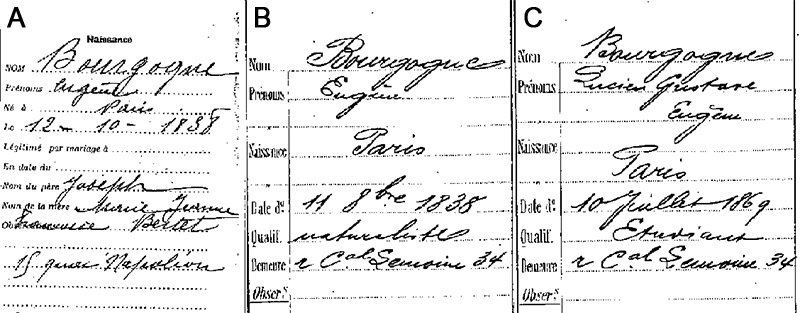
Figure 18.
(A and B) Birth and 1891 voter records of Eugene Bourgogne. (C) The 1891 voter record of his son, Lucien, who was born on July 10, 1869.
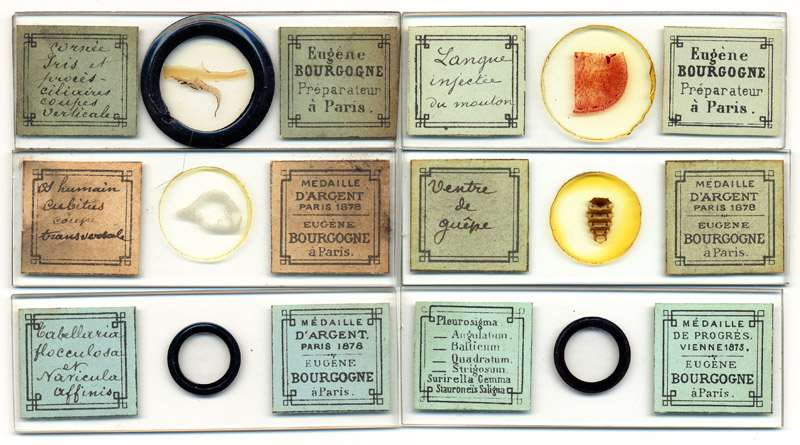
Figure 19.
A selection of microscope slides that were prepared by Eugene Bourgogne. Dates of production can be approximated by the awards that he listed on his labels.
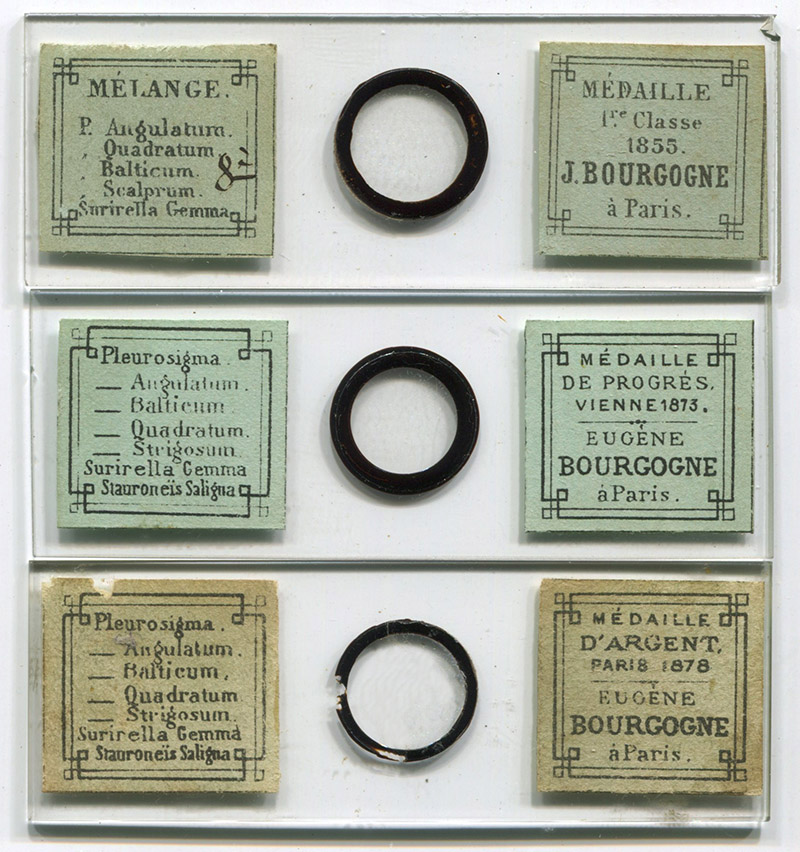
Figure 20.
Evidently a popular diatom preparation, these are the only Bourgogne slides with pre-printed specimen labels of which I am aware. These were mounted by both Joseph and Eugene, with the middle slide announcing Eugene’s 1873 Vienna prize, and the lower slide announcing his 1878 Paris prize. Joseph was reported to be the main source of mounted Pleurosigma angulatum from 1850 onward; these slides may represent those diatom mounts.
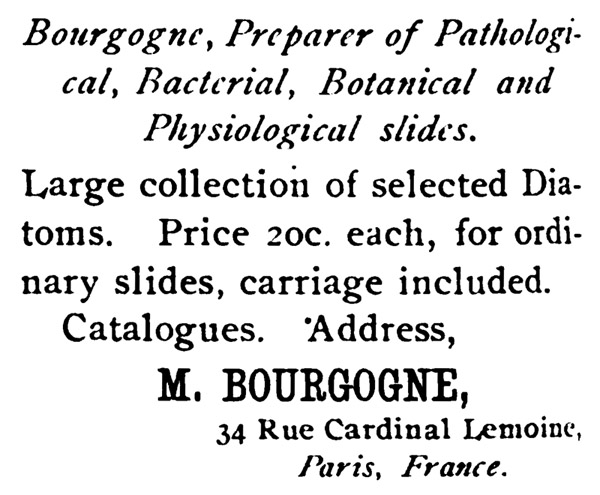
Figure 21.
An 1895 advertisement from Eugene Borgogne, which appeared in ‘The American Monthly Microscopical Journal’.
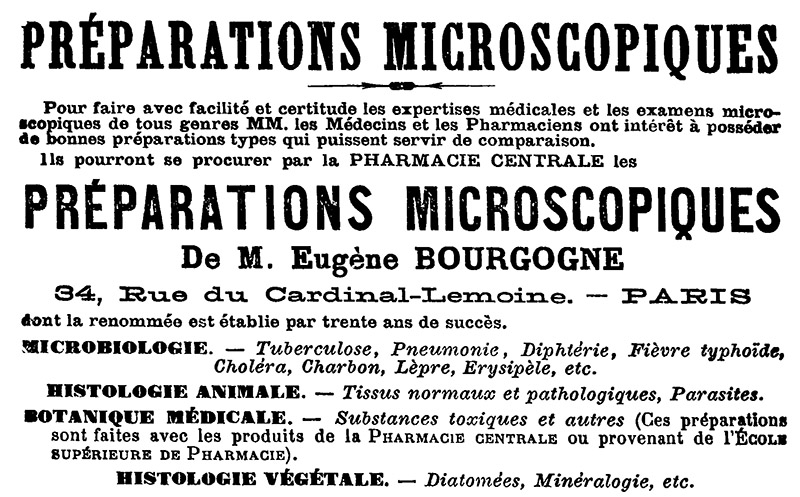
Figure 22.
An 1895 advertisement from ‘Bulletin Commercial’.
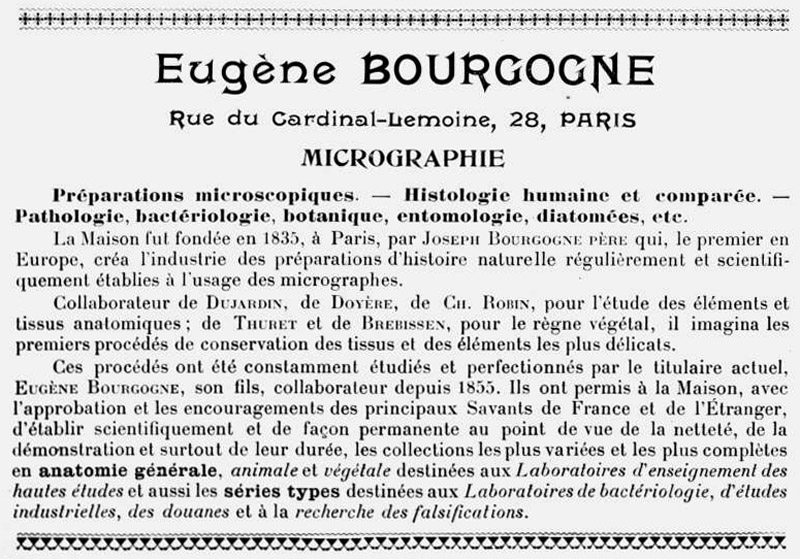
Figure 23.
A description of Eugene Bourgogne’s business, from Cornu’s ‘L'Industrie Française des Instruments de Précision, 1901-1902’ . It notes that Joseph Bourgogne began his business in 1835 and Eugene became a partner in 1855.
Bourgogne Frères (Bourgogne Brothers)
Trade directories indicate that Eugene left his father’s shop during 1860, and took up with brother-in-law Hippolyte Claude Pouilliart at 9 Rue de Rennes (Figure 28). They were described as “frères”. The partnership lasted until around 1866, when Pouilliart evidently formed a partnership with Alliot, and Eugene began working alone.
The partnership of “Bourgogne frères, a Paris, rue de Rennes, 9” displayed “preparations microscopiques d’anatomie animale et vegetale” at the 1862 London Exhibition. The French-language catalogue stated, “atelier fonde en 1860” (“workshop founded in 1860”). They earned an Honourable Mention. The catalogue listed the contact for Bourgogne Fréres as “Bourgogne (E.)”, and Pouilliart listed this award on his later "H Bourgogne" slide labels (Figure 27).
Thus, microscope slides labeled “Bourgogne Frères” were produced by Eugene Bourgogne and H. Pouilliart between 1860 and ca. 1866.
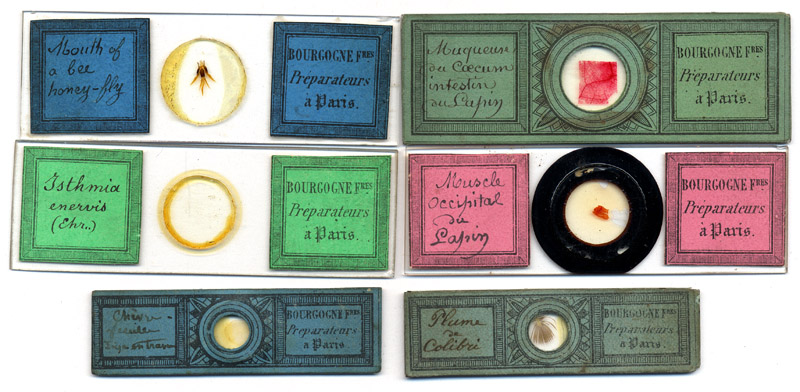
Figure 24.
Microscope slides that were prepared by "Bourgogne Frères" between 1860 and ca. 1866.
Hippolyte Claude Pouilliart, "H. Bourgogne", and Bourgogne - Pouilliart
"H Bourgogne" has long been a mystery. I suggested in a 2009 paper that "H" might have been a parternship between Eugene and Charles, which was later disproved by conclusive evidence that "H Bourgogne" was truly a separate person. Brian Bracegirdle, in his 1998 Microscopical Mounts and Mounters, suggested the name “Henri”, although no evidence was provided. Several Bourgognes named Henri, and Hippolyte and other “H” names, lived in Paris during the mid-1800s, but none can be tied to the microscopist.
My investigations during 2022 discovered that Joseph Bourgogne's elder daughter, Marie Rose, married an "opticien" named Claude Pouilliart in 1850. Records of their children gave Pouilliart's first name as either "Claude" or "Hippolyte". He operated under his own name for several years, but began using the business name "H Bourgogne" around 1859, possibly to capitalize from association with his famous father-in-law.
Pouilliart operated a slide-making business under the name "H. Pouilliart" during the 1850s (Figure 25). He exhibited “preparations microscopiques” at the 1855 Paris International Exhibition. He then worked from 45 Rue Payanaux, in the Belleville area of Paris (Figure 26).
The 1860 Annuaire Général du Commerce et de l'Industrie, de la Magistrature et de l'Administration, which would have been prepared during 1859, listed "H Bourgogne" as the proprietor of a microscope preparation business at 16 Rue Chanoinesse (Figure 28). Slides by "H Bourgogne" that are dated 1859 are known, suggesting that Pouilliart began using that name around than (Figure 27).
During 1860, Pouilliart moved to 9 Rue de Rennes, and was joined by Eugene Bourgogne (Figure 28). The pair then operated as “Bourgogne Frères” (see above).
Around 1866, Eugene left the partnership. Microscope slides that are labeled "H. Bourgogne & Pouilliart", with address 9 Rue de Rennes, probably date from that time. If so, than Pouilliart could have been bringing his real surname to his customers, while retaining a tie to the Bourgogne name. Pouilliart's ca. 1867 partnership with C. Alliot operated from 3 Rue de Départ - the grey-labeled slide shown in Figure 29, below, probably dates from the time of Pouilliart's move.
The 1870 Annuaire Général du Commerce et de l'Industrie, de la Magistrature et de l'Administration lists the 3 Rue de Départ business as simply “Bourgogne” (Figure 28). Some "H Bourgogne" slides have labels that mention the 1867 medal, indicating that Pouilliart later operated alone and under the Bourgogne name (Figure 27). Slides labeled "Pouilliart - Bourgogne" probably also date from after the 1867 Exhibition, as Pouilliart was establishing his name to customers (Figure 29).
No records mentioning "H Bourgogne" are known after 1870.
Pouilliart and Marie Rose Bourgogne lived at 35 Passage St. Victor at the time of the October 20, 1869 birth of their son Louis Eugene. When daughter Leonie Marie Pouilliart married in 1875, the Pouilliart-Bourgogne family lived at 22 Rue de Braziers. Throughout his life, Pouilliart worked as an optician, although I have not found signed evidence of his work other than microscope slides. Marie Rose also worked throughout her life, as a seamstress and maker of lingerie.
Hippolyte Claude Pouilliart died on January 22, 1895. His widow died on July 9, 1899, at 27 Rue de la Parcheminerie.
H.C. Pouilliart was a younger brother of Claude-Maxime Pouilliart (1822-1882), who manufactured scientific and medical instruments at 4 Rue Schomer, Vaugirard, Paris. In April, 1857, he was awarded a patent for “perfectionnements à des instruments d'optique” (“improvements to optical instruments”) (Figure 32).

Figure 25.
Very rare microscope slides by Hippolyte Pouilliart. His first name is abbreviated as "Hte.". All of the slides are continental-sized slides. The upper left slide, with gold printing on red paper, is printed “1st Choix” (first choice), while the black on green slides are labeled “3rd Choix” (third choice).
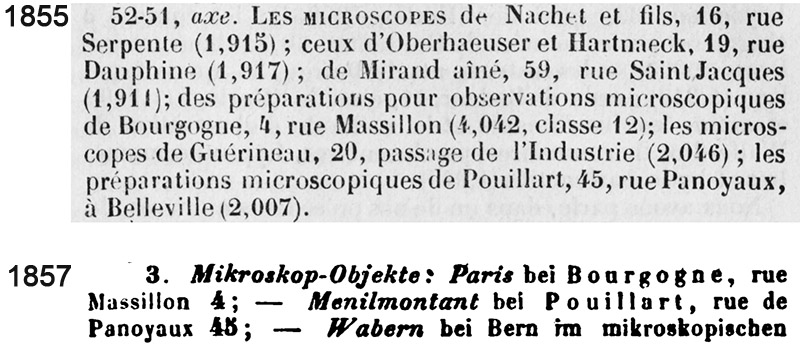
Figure 26.
1855 and 1857 published notes on microscope slide-maker H. Pouilliart.

Figure 27.
Microscope slides labeled with "H. Bourgogne" (made by H. Pouilliart). The upper left slide is dated 1859, and both of the left-hand slides probably date from that year or 1860, before Eugene Bourgogne joined as a partner to form "Bourgogne Freres". The two slides on the right, with green labels, proclaim the 1862 Honourable Mention that was won by Bourgogne Frères, and the 1867 Bronze Medal that was won by Bourgogne and Alliot. Those slides confirm that H was a partner of both Bourgogne Fréres and Bourgogne & Alliot, and indicate that H worked alone for some length of time after 1867.

Figure 28.
Extracts from the Parisian ‘Annuaire Général du Commerce et de l'Industrie’. Addresses for "H Bourgogne", and other family members, are shown, as are also lists of the occupants of the buildings that housed "H Bourgogne" in 1860 and 1861.

Figure 29.
Rare microscope slides labeled by Bourgogne/Pouilliart. The combined names were probably efforts by Hippolyte Pouilliart to bring his real surname to the attention of customers, as he was no longer working with Eugene Bourgogne. The Bourgogne Freres parternship operated from 9 rue des Rennes through 1866. The address has been carefully blacked out from the label on the righthand small slide, suggesting prodcution before, but sale after, Pouilliart moved to 3 Rue de Départ. The slides shown on the lower row probably date from after the 1867 Exposition, when Pouilliart would have continued to establish his name in the business. These slides are slightly larger than standard, measuring 1 1/8 x 3 1/8 inches (29 x 79 mm).
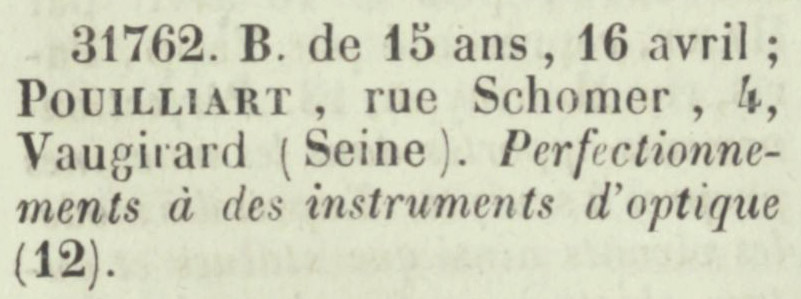
Figure 30.
An 1857 announcement of the award of a patent to Claude Maxime Pouiliart (elder brother of Hippolyte Claude Pouilliart) for improvements to optical instruments.
Bourgogne and Alliot / C. Alliot
The earliest known description of this partnership comes from an August 1, 1866, paper on tooth structures by J.H. M’Quillen, “This is markedly the case in a specimen prepared by Burgogne and Alliot, of Paris, which my friend, Dr. W.S. Bowdoin, of Salem, Mass., placed in my hands the day on which this communication was made to the Association. Having described the appearance of my preparation to him the evening before, he said that some microscopical sections imported by him from France had just been received, and he would like me to examine them. The one referred to was among these, and is a very valuable specimen, particularly in illustration of these spaces”.
Bourgogne and Alliot entered a display of slides at the 1867 Paris International Exposition, and won a Bronze Medal. A brief description of their entry, in La Propagation Industrielle, gave their address as 9 Rue de Rennes. All other records give their address as 3 Rue de Départ. This suggests that they moved their shop just before the Exposition began.
Their display was described as “préparations microscopiques d'objets d'anatomie. Exécution tout à fait remarquable. Les préparations sont parfaitement bien formées. Citons entre autres: des coupes de dents, dans diverses directions, fie l'homme, du cheval, et de divers animaux. Section du système nerveux, coupe d'os. Petits animaux. Préparations botaniques”.
M.C. Cooke wrote of the Paris Exposition, “Microscopic objects are exhibited in the British section by Mr. Topping and Mr. Norman, of London, Mr. Cole, of Liverpool, and Mr. Webb, of Birmingham; and in the French department by Messrs. Burgogne and Aliot. These require a more careful survey than I have yet been able to make, before any special objects can be indicated. Messrs. Burgogne's injections attracted much attention in 1862, but the display here is far inferior in number, though probably fully equal in quality”.
I have yet to identify any records of Bourgogne and Alliot after the 1867 Paris Exposition. As noted above, an 1870 directory listed “Bourgogne” at 3 Rue de Départ, but the absence of Alliot’s name implies that he was no longer a partner (Figure 28). I do not know of any Bourgogne and Alliot slides that list their Bronze Medal, suggesting that the partnership was brief and ended with the Exposition.
"H. Bourgogne" (H. Pouilliart) was certainly a partner in Bourgogne and Alliot, as demonstrated by his proclamation of the 1867 Bronze Medal on his later slide labels (Figure 27).
Although Bourgogne and Alliot appear to have initially operated from 9 Rue de Rennes, which was the home of the Bourgogne Fréres partnership between Pouilliart and Eugene Bourgogne, it is most probable that Eugene was not a partner of Bourgogne and Alliot. His failure to mention the 1867 Bronze Medal implies that he was not involved with the Paris Exposition. As noted above, Eugene married in early 1867, prior to the Exposition, and was certainly working alone by 1868.
Partner Alliot has yet to be conclusively identified. Alliot later operated his own operation in Silly en Gouffern, Orne (Figure 32). Labels on those slides indicate that his first name began with the letter C.
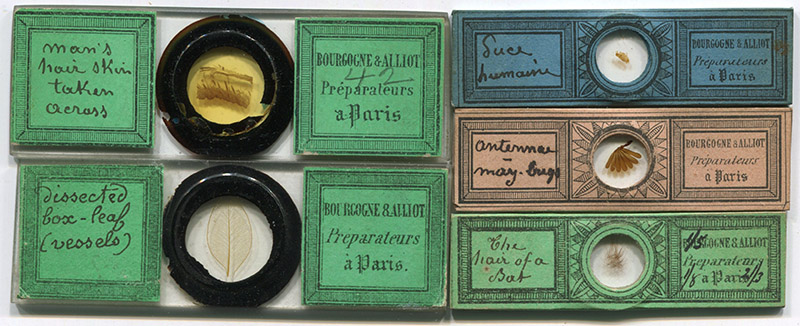
Figure 31.
Microscope slides labeled by Bourgogne and Alliot. None of their slides mention their Bronze Medal from the 1867 Paris Exposition, suggesting that they were produced either before or during the Exposition, thereby dating them to ca. 1866 - 1867. Specimen descriptions in French or English indicate that Bourgogne and Alliot produced material for both domestic and foreign markets.
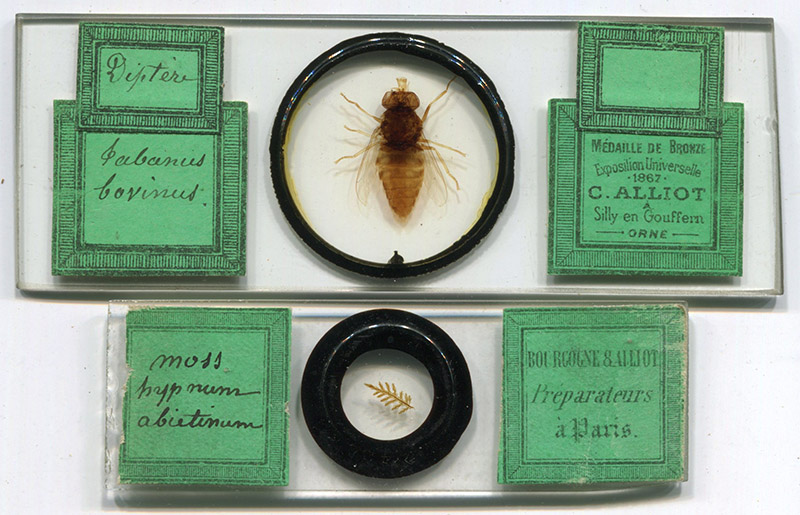
Figure 32.
A slide labeled by C. Alliot alone, when he was in Orne. Note that Alliot claimed to have won the Bronze Medal at the 1867 Exposition, confirming that this was the same person who partnered with Bourgogne. This unusually-large slide measures 1 1/2 x 4 1/8 inches (37 x 103 mm). A standard-sized (1 x 3 inch) by Bourgogne and Alliot is shown for comparison.
Unsigned microscope slides attributable to the Bourgogne family
Slides with labels and handwriting that match those of signed Bourgogne preparations were probably prepared for manufacturers of microscopes, to be included with instruments. Small, paper-wrapped “Continental”-sized slides are relatively common, while larger slides or unwrapped preparations are generally scarce. Continental-sized slides were often included with small drum-type microscopes, which have stages that are too restricted for standard-sized slides.

Figure 33.
Unsigned microscope slides that were probably made by one or more Bourgogne. They bear labels like those used by Bourgogne partnerships (compare with Figures 9, 10, 11 and 12). The handwriting on such slides also resembles that of Bourgogne family members.
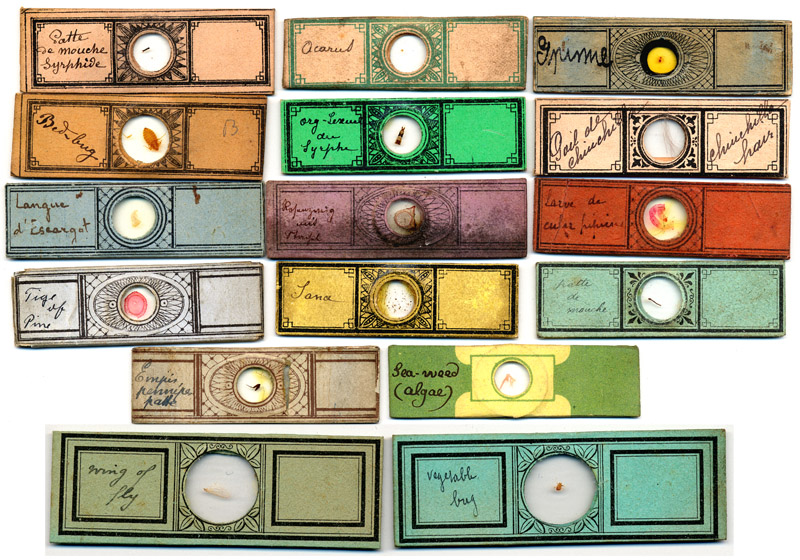
Figure 35.
Unsigned microscope slides that were probably made by the Bourgognes. The labels are patterned like theirs, and the handwriting often resembles that of Bourgogne family members. The upper slides are continental sized. These small slides are frequently found nowadays accompanying small French microscopes, and were likely original to those instruments. The lower two slides are uncommon, being of the standard 1x3 inches in size. These unattributed slides were probably made for distribution through microscope retailers. They can be found in a variety of colors, with several different patterns, and specimen descriptions may be in French, English or German.
Acknowledgements
Many thanks to Jeroen Meeusen and Ted Bernhardt for their insightful comments and assistance.
Resources
Almanach Général des Commerçans de Paris (1840) page 694
Almanach de plus de 45,000 Adresses du Commerce de Paris (1843) page 285
Almanach des 40,000 adresses des fabricants de Paris (1868) page 203
Annales de la Société Entomologique de France (1999) Obituary of Jean Bourgogne, “Son grand-père paternel, Eugène Bourgogne, exerçait la profession de micrographe. Il habitait et travaillait rue du Cardinal Lemoine, proche du Jardin des Plantes où il emmenait son petit-fils presque chaque semaine”, Vol. 35, page 231
Annuaire-Almanach du Commerce de Paris (1854) page 127
Annuaire-Almanach du Commerce de Paris (1857) page 456
Annuaire-Almanach du Commerce de Paris (1858) page 113
Annuaire-Almanach du Commerce de Paris (1859) page 136
Annuaire-Almanach du Commerce de Paris (1860) pages 136, 439, 878, and 1094
Annuaire-Almanach du Commerce de Paris (1861) pages 145, 455, 927, and 1282
Annuaire-Almanach du Commerce de Paris (1862) pages 146, 602-603, and 1218
Annuaire-Almanach du Commerce de Paris (1863) pages 152 and 603
Annuaire-Almanach du Commerce de Paris (1864) pages 97, 152, 482-483, 604 and 1401
Annuaire-Almanach du Commerce de Paris (1870) pages 158 1171, 1172, 1474, 1476, 1500, and 1646
Annuaire-Almanach du Commerce de Paris (1880) pages 1392 and 1826
Annuaire-Almanach du Commerce de Paris (1884) page 1588
Annuaire-Almanach du Commerce de Paris (1887) page 207
Annuaire-Almanach du Commerce de Paris (1893) page 2469
Annuaire-Almanach du Commerce de Paris (1896) page 1909
Annuaire-Almanach du Commerce de Paris (1898) page 2015
Annuaire Général du Commerce et de l'Industrie, de la Magistrature et de l'Administration (1837) page LVI
Annuaire Général du Commerce et de l'Industrie, de la Magistrature et de l'Administration (1838) page 246
Annuaire Général du Commerce et de l'Industrie, de la Magistrature et de l'Administration (1839) page 448
Annuaire Général du Commerce et de l'Industrie, de la Magistrature et de l'Administration (1840) pages 149 and 535
Annuaire Général du Commerce et de l'Industrie, de la Magistrature et de l'Administration (1841) page 106
Annuaire Général du Commerce et de l'Industrie, de la Magistrature et de l'Administration (1846) page 148
Annuaire Général du Commerce et de l'Industrie, de la Magistrature et de l'Administration (1847) page 38
Annuaire Général du Commerce et de l'Industrie, de la Magistrature et de l'Administration (1853) page 695
Annuaire Général du Commerce et de l'Industrie, de la Magistrature et de l'Administration (1855) pages 125 and 748
American Monthly Microscopical Journal (1895) Advertisements from Eugene Bourgogne, Vol. 16, published in numerous issues through the year
Annales de la Societe Entomologique de France (1999) Obituary of Jean Bourgogne, Vol. 35, page 231
Anderson, Thomas M. (1861) On the Parasitic Affections of the Skin, J. Churchill & Sons, London, page 120
Annuaire Général du Commerce et de l'Industrie (1847) “Bourgogne, preparations microscopiques, Constantine, 6”, page 38
Annuaire et Almanach du Commerce, de l'Industrie, de la Magistrature et de l'Administration (1862) “Bourgogne (H. et E.), freres, preparations microscopiques, anatomie animale et vegetale pour l'etude, fournieseurs de plesieure ecoles et musees de France et de l'etranger, Rennes 9 .. Bourgogne (Jh), pere, preparateur d'anatomie generale des animale et vegetale pour les etudes microscopiques, 4 medalles 1844-49-51 et Ire el. 1855, Massillon 4 (Cite)”, Didot et Bottin, pages 146 and 602-603
Anthony, John (1874) The scales of Lepisma as seen with reflected and transmitted light, The Monthly Microscopical Journal, Vol. 11, pages 193
Berichte Hamburger Gewerbetreibender über die Pariser Ausstellung (1867) pages 151-152
Birth record of Charles Bourgogne (1832) Obtained through www.ancestry.fr
Birth record of Eugene Bourgogne (1838) Obtained through www.ancestry.fr
Bourgogne, Joseph (1862) Prix Courant des Preparations Microscopiques.
Bracegirdle, Brian (1978) A History of Microtechnique, Science Heritage, Lincolnwood, Illinois.
Bracegirdle, Brian (1998) Microscopical Mounts and Mounters, Quekett Microscopical Club, London, pages 16-17, 106, 108, 110, 118, 120, and plates 1D, 2F, 2K, 3B-E, 7P-U, and 8-A-T
Bracegirdle, Brian and Stanley Warren (2000) Microscopical mounts and mounters: addenda [3], Quekett Journal of Microscopy, Vol. 38, pages 457-462
Bulletin Commercial (1890) Advertisement from Eugene Bourgogne, November issue, page 720
Bulletin Commercial (1895) Advertisement from Eugene Bourgogne, November issue, page 727
Bulletin des Lois de l’Empire Français (1858) “Le brevet d'invention de quinze ans, don’t le demande a éte deposée, le 15 avril 1857, au secrétariat de la préfecture du départment de la Seine, par le sieur Pouillart (Claude-Maxime), rue Schomer, no 4 , à Vaugirard, pour des perfectionnements à des instruments d'optique”, page 700
“C. J. B. F.” (1856) Microscopical preparation (query), English Mechanic and World of Science, Vol. 26, page 635
Catalogue des Brevets d'Invention (1858) page 98
Catalogue General – Exposition Universelle de 1867, a Paris, (1867) E. Dentu, ed., Classe 12, page 62.
Catalogue officiel publie par ordre de la commission imperiale: Exposition des produits de l'industrie de toutes les nations 1855, pages 49 (Pouillart) and 89 (Bourgogne)
Catalogue Officiel, Section Français (1862) “Bourgogne (J.) pere, a Paris; rue Massillon, 4. – Preparations microscopiques pour l’etude de l’anatomie et de l/histoire naturelle, Atelier fonde en 1835 et frabrique collective”, pages 127-128
Catalog��ue Officiel - Exposition Universelle Internationale de 1878, a Paris (1878) tome II, section Francaise, groupes II a VI, Classes 6 a 68, page 97.
Clarke, L. Lane (1870) Objects for the Microscope: Being a Popular Description of the Most Instructive and Beautiful Subjects for Exhibition, 3rd edition, Groombridge and Sons, London, page 202.
Cook, Mordecai C. (1867) A voice from Paris, Hardwicke’s Science-Gossip, Vol. 2, pages 97-99.
Cornu, Alfred (1902) Eugene������ Bourgogne, L'Industrie Française des Instruments de Précision, 1901-1902.
Dickerson, Edward A. (1870) Microscopic amplification, Hardwicke’s Science-Gossip, Vol. 6, page 230.
Dixon, Edmund Saul (1857) Microscopic prep����arations, originally appearing in Charles Dickens’ Household Words, vol. 16, reprinted in The Living Age, Vol. 55, pages 346-352.
Ellis, Robert (1851) Official Descriptive and Illustrated Catalogue of the Great Exhibition of the Works of Industry of all Nations, Spicer Brothers, London, pages lxxix and cxxvi.
Exposition Universelle de 1862, a Londres, Section Française, Catalogue Officiel (1862) Imprimerie Impériale, Paris, pages 127-128, and 242.
Frey, Heinrich, Johann F. Frey, Paul Spillmann (1867) Le Microscope: Manuel à L'usage des Étudiants, pages 223, and 250-251.
Girodet, Pierre (2000) Mounters, collectors and sellers of microscopical mounts in France in the 19th and 20th centuries [1] A-L, Quekett Journal of Microscopy, Vol. 38, pages 573-592
Girodet, Pierre (2001) The 1862 Joseph Bourgogne catalogue of microscopical preparations (English translation with notes), Quekett Journal of Microscopy, Vol. 39, pages 39-52
Hardwicke’s Science-Gossip (1866) Notices to correspondents, Vol. 1, page 96
van Heurck, Henri F. (1869) Le Microscope: La Construction, Son Maniement et Son Application aux Études d'Anatomie Végétale, Baillière et fils, Paris, page 200
Husnot, T. (1879) Nouvelles, Revue Bryologique, no. 4, page 64
Jahrbucher der In- and Auslander Gesammten Medicin (1857) Notes on producers of microscope slides, “Paris bei Bourgogne, rue Massillon .. Menilmontant bei Pouillart, rue de Panoyaux 45”, Vol. 93, page 144
Johnston, Christopher (1858) On a method of preparing and mounting hard tissues for the microscope, American Journal of Science and Arts, Second Series, Vol. 25, pages 232-235
Journal de Micrographie (1877) Advertisements from Joseph and Eugene Bourgogne, Vol. 14, at the rears of the September and October issues, respectively
Journal de la Societe Imperiale et Central��e d’Horticulture de France (1868) “Une lettre de M. Eug. Bourgogne, fabricant de préparations pour le microscope, rue des Fossés-St-Victor, 6”, page 517
Edouard Lamy de la Chapelle, Eduard (1880) Catalogue des Lichens du Mont-Dore et de la Haute-Vienne, Societe Botanique de France, Paris, page xi
Marriage record for Joseph Bourgogne and Marie Bertet (1828). Obtained through www.ancestry.fr
Medals and Honourable Mentions Awarded by the International Juries (1862) Her Majesty's Commissioners, London, page 225
La médecine a L’Exposition Universelle de 1867, Guide-Catalogue (1867) edited by Germer Baillière, ed., page 18
The Medical Times (1851) The Great Exposition, New series, Vol. 3, pages 387-390
Meschiari, Alberto (2001) Registro del visitatori dello Studio di Giovanni Battisit Amici, Atti Della Fondazione Giorgio Ronchi, Vol. 56, page 473
The Microscope (1893) Vol. 1, page 79
Le Moniteur Scientifique (1867) Exposition Universelle de 1867 – Prix et Recompenses, Vol. 9, page 603.
M’Quillen, J.H. (1866) The interglobular spaces in dentine, The Dental Cosmos new series, Vol. 8, page 115
Nouveau Manuel Complet du Fabricant d'Objets en Caoutchouc en Gutta-Percha (1855) “Nous passons sous silence beaucoup d'autres objets qui sont exécutés par le fabricant de gomme factice, tels que visières de casquettes, bols ou cuvettes, ceintures. L'artiste habile à qui nous devons les renseignements qui précèdent et qui a bien voulu mettre à notre disposition des échantillons de ses produits, est à la tête d'une exploitation considérable et d'un grand nombre d'ouvriers; il a la confiance des médecins et fait en France et à l'étranger un écoulement considérable de ses produits qui sont généralement estimés. M. Pouilliart-Libault succède à un père justement estimé, ses ateliers sont situés à Plaisance, commune de Vaugirardj rue Schomer, no. 4”, page 352
Nuttall, Robert H. (2006) Marketing the achromatic microscope: Andrew Pritchard’s engiscope, Quekett Journal of Microscopy, Vol. 40, pages 309-330
Nylander, M.W. (1878) De theoria algo-lichenica, Revue Internationalle des Sciences, Vol. 2, page 382
Nylander, M.W. (1878) De theoria algo-lichenica, Association Francaise pour l’Advancement des Sciences, 7th session, pages 705-706
Official Descriptive and Illustrated Catalogue (1851) pages lxxix and cxxvi
Pelletan, Jules (1876) Le microscope: Son Emploi et Ses Applications, G. Masson, Paris, pages 60, 153, 177, 180, 188, 219, 239, 256, 279, 313, 330, 364, 526, 572, 557, 578, and 581
Le Progrès Manufacturier (1855) page 281
La Propagation industrielle (1867) page 88
Quarterly Journal of Microscopical Science (1866) Proceedings of societies: the Birmingham Natural History and Microscopical Society, Vol. 6, page 196
Rapport du Jury Central sur les Produits de l'Industrie Francaise (1839) “Bourgogne. Preparations d’objets microscopiques. C.F.”, page 489
Rapport du Jury Central, Exposition des Produits de L’industrie Francaise (1844) “M. Bourgogne, à Paris, rue Constantine, 6, et rue des Marmousets, 17. M. Bourgogne a acquis dans les préparations microscopiques une supériorité incontestable; personne n'a porté au même degré l'art si délicat d'ajuster entre deux verres, et de conserver pendant longtemps, les insectes, les animalcules, les organes séparés, et en un mot, tous les éléments infiniment petits des trois règnes qui ne peuvent être étudiés qu'au microscope. Les collections qu'il a présentées à l'exposition sont d'un grand intérêt. Le jury décerne à M. Bourgogne une médaille de bronze” , Vol. 3, pages 489-490 and 725
Rapport du Jury Central sur les Produits de l'Agriculture et de l'Industrie Exposes (1849) pages 251-252
Reiche, L. (1856) Communications, Annales de la Societe Entomologique de France, Third series, Vol. 4, page xvi.
Revue des Sciences Naturelles (1872) Boehm, Paris, page 185.
Robin, Charles (1856) Memoire sur les Objets qui Peuvent etre Conserves en Preparations Microscopiques, Bailliere, Paris, page 5.
Robin, Charles (1871) Traité du Microscope, J.B. Baillière, Paris, page 387
Robin, Charles (1877) Traité du microscope et des injections, J.B. Baillière, Paris, pages 302-303.
“Rusticus, Jr.” (1880) Microscopy – past and present, English Mechanic and World of Science, Vol. 30, pages 570-571.
Stevenson, Brian (2009) The Bourgogne brothers Eugene and Charles, and the riddle of “H. Bourgogne”, Quekett Journal of Microscopy, Vol. 41, pages 63-64.
L’Union Médicale (1859) Notice sur la gale et sur l’animalcule qui la produit, , Vol. 3, page 313.
Voter registration records for Charles, Eugene and Lucien Gustave Eugene Bourgogne (1891). Obtained through www.ancestry.fr
Voter registration record for Eugene Bourgogne (1908) Obtained through www.ancestry.fr
Voter registration record for Lucien Gustave Bourgogne (1919) Obtained through www.ancestry.fr
Western Lancet (1872) Proceedings of the San Francisco Microscopical Society, Vol. 4, pages 43 and 318.